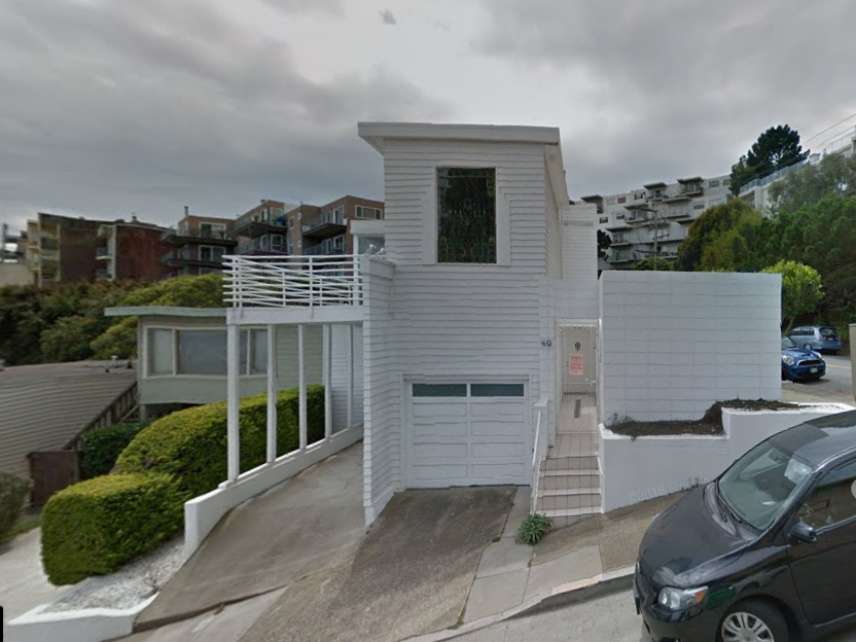City Officials Ordered San Francisco Man To Rebuild Exact Replica of Demolished Home. Now He's Fighting Back.
City officials determined years ago that the home was of no historic value.

Back in December, the San Francisco Planning Commission ordered property owner Ross Johnston to rebuild an exact replica of a mid-1930s home he had torn down, lambasting him for destroying a historic home without obtaining the necessary permits.
Johnston is now hitting back, calling the city's decision both absurd and lawless, and demanding that he be allowed to continue with the redevelopment of his property.
"The Planning Commission decision is invalid, bizarre, and illegal," said Andrew Zacks, an attorney for Johnston, in a statement. Zacks argues that the order is baseless and runs against both the city's designation that Johnston's house—also known as the Largent House, after its original owner—was not of historical significance, and permits it had already issued that allowed for substantial renovations to his property.
The controversy around Johnston's home—located in San Francisco's Twin Peak's neighborhood—got rolling back in late 2017, when neighbors began to complain that the renovation work on the Largent House had resulted in demolition of the entire structure, save for the original garage. The home had originally been designed by famed modern architect Richard Neutra.
This sparked outrage, and eventually, the intervention of the city's Planning Commission, which last month ordered Johnston to rebuild the home exactly as it was, save for a small plaque explaining that it is a replica home, a decision the San Francisco Chronicle referred to as "unprecedented."
Johnston also got a tongue-lashing from San Francisco Supervisor Aaron Peskin, who told the Chronicle: "The fact that it was a unanimous vote should send a message to everyone that is playing fast and loose that the game is over. We want to preserve iconic, historic structures, but even more important, we want to protect our reservoir of more affordable housing stock."
Missing from the outrage over the demolition of Johnston's home were some crucial details.
The first is that the home, at least as a matter of law, was not actually a historic resource of any kind.
Since its original construction, the Largent House has undergone extensive alterations, including the construction of a 20-foot retaining wall back in the 1950s, major fire damage repair in the 1960s, the addition a swimming pool in the 1980s, and the enclosure of said pool in the 1990s. A second floor was also added above the garage at some unknown date.
All these changes—plus the fact that no historically significant events are known to have occurred at the house—saw the city's Planning Department declare in early 2015 that the home was not a historic resource.
"The subject property has also been altered so that it is impossible to know the original design intention of Neutra," reads a January 2015 report from the Planning Department, noting that no photos of the initial design of the house exist.
Because of this lack of historical significance, the city issued permits in 2014 to allow for substantial renovations to the home that would have seen the one-bedroom, roughly 1,300-square-foot home converted into a 3-story, 3,600-square-foot home sporting four bedrooms.
Johnston's attorneys are arguing both the lack of historical significance, and the prior approval of substantial alterations makes, the order to rebuild the Largent House patently absurd.
Johnston's lawyers do concede that some of the demolition work done on the home exceeded what was allowed by those 2014 permits, but they argue that this was done for safety reasons when remodeling work in 2017 revealed several walls were not solid concrete, and thus would not support the alteration work approved by that 2014 permit.
The walls were thus removed, and an after-the-fact demolition permit was requested.
This horrifying decision, while unique, is in keeping with San Francisco's nonsensical housing policies.
Reason has covered the case of Robert Tillman, who was forced to spend $23,000 producing a 135-page report proving that a laundromat he owns in the city's Mission District—and which he has been trying to convert into an apartment building—is not, in fact, historically significant.
In a similar case, another San Francisco man looking to build a home on a vacant lot he owns in the city's Glen Park neighborhood had to fend off the claims of neighbors who argued that a dirt path running through said vacant lot was actually a historic trail used by early Spanish Missionaries. Preservation of said dirt path took precedence over the construction of a home in the housing-starved city, they argued (ultimately without success).
San Francisco's clunky bureaucracy will ensure that Johnston's appeal stretches out for a while. It likely won't be cheap for him, either.
In the meantime, the Planning Commission's standing order that an expensive replica of an imagined past be rebuilt in lieu of new housing can serve as a good illustration of the attitude many in the city take toward new development.
Rent Free is a weekly newsletter from Christian Britschgi on urbanism and the fight for less regulation, more housing, more property rights, and more freedom in America's cities.


Show Comments (99)